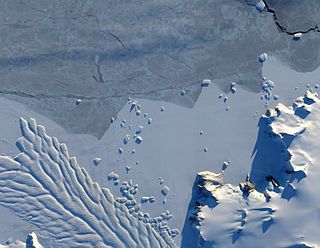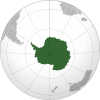
Thurston Island is an ice-covered, glacially dissected island, 215 km (134 mi) long, 90 km (56 mi) wide and 15,700 km2 (6,062 sq mi) in area, lying a short way off the northwest end of Ellsworth Land, Antarctica. It is the third-largest island of Antarctica, after Alexander Island and Berkner Island.
The Horlick Mountains are a mountain group in the Transantarctic Mountains of Antarctica, lying eastward of Reedy Glacier and including the Wisconsin Range, Long Hills and Ohio Range.
The Reedy Glacier is a major glacier in Antarctica, over 100 nautical miles long and 6 to 12 nautical miles wide, descending from the polar plateau to the Ross Ice Shelf between the Michigan Plateau and Wisconsin Range in the Transantarctic Mountains. It marks the limits of the Queen Maud Mountains on the west and the Horlick Mountains on the east.

The Darwin Glacier is a large glacier in Antarctica. It flows from the polar plateau eastward between the Darwin Mountains and the Cook Mountains to the Ross Ice Shelf. The Darwin and its major tributary the Hatherton are often treated as one system, the Darwin–Hatherton.

Bear Peninsula is a peninsula about 80 km (50 mi) long and 40 km (25 mi) wide which is ice-covered except for several isolated rock bluffs and outcrops along its margins, lying 48 km 30 mi) east of Martin Peninsula on Walgreen Coast, Marie Byrd Land, Antarctica.

Shackleton Ice Shelf is an extensive ice shelf fronting the coast of East Antarctica from 95° E to 105° E. It extends for an along-shore distance of about 384 kilometres (239 mi), projecting seaward about 145 kilometres (90 mi) in the western portion and 64 kilometres (40 mi) in the east. It occupies an area of 33,820 square kilometres (13,058 sq mi). It is part of Mawson Sea and separates the Queen Mary Coast to the west from the Knox Coast of Wilkes Land to the east.

Lambert Glacier is a major glacier in East Antarctica. At about 80 km (50 mi) wide, over 400 km (250 mi) long, and about 2,500 m (8,200 ft) deep, it is the world's largest glacier. It drains 8% of the Antarctic ice sheet to the east and south of the Prince Charles Mountains and flows northward to the Amery Ice Shelf. It flows in part of Lambert Graben and exits the continent at Prydz Bay.
The Vestfold Hills are rounded, rocky, coastal hills, 512 square kilometres (198 sq mi) in extent, on the north side of Sorsdal Glacier on the Ingrid Christensen Coast of Princess Elizabeth Land, Antarctica. The hills are subdivided by three west-trending peninsulas bounded by narrow fjords. Most of the hills range between 30 and 90 metres in height, with the highest summit reaching nearly 160 metres (520 ft).
Scott Glacier is a glacier, 7 miles (11.3 km) wide and over 20 miles (32 km) long, flowing north-northwest to the Antarctic coast between Denman Glacier and Mill Island. It was discovered by the Western Base Party of the Australasian Antarctic Expedition (1911-1914) under Mawson and named for Capt. Robert F. Scott.

The David Glacier is a glacier over 60 nautical miles long, flowing east from the polar plateau through the Prince Albert Mountains to the coast of Victoria Land, Antarctica. It enters Ross Sea between Cape Philippi and Cape Reynolds to form the floating Drygalski Ice Tongue. It is the most imposing outlet glacier in Victoria Land. It is fed by two main flows which drain an area larger than 200,000 square kilometres, with an estimated ice discharge rate of 7.8 +/- 0.7 km³/year. The David Glacier was discovered by Ernest Shackleton's "Northern Party," in November 1908, under the leadership of Prof. T.W. Edgeworth David, of Sydney University, for whom the feature was named.

The Secret Land is a feature-length 1948 documentary film about the United States Navy expedition code-named "Operation Highjump" to Antarctica in 1946. The film, which was shot entirely by USN and US Army military photographers, focuses on the mission to explore the polar region and evaluate its potential for military operations.

Posadowsky Glacier is a glacier about 9 nautical miles long, flowing north to Posadowsky Bay immediately east of Gaussberg. Posadowsky Bay is an open embayment, located just east of the West Ice Shelf and fronting on the Davis Sea in Kaiser Wilhelm II Land. Kaiser Wilhelm II Land is the part of East Antarctica lying between Cape Penck, at 87°43'E, and Cape Filchner, at 91°54'E, and is claimed by Australia as part of the Australian Antarctic Territory. Other notable geographic features in this area include Drygalski Island, located 45 mi NNE of Cape Filchner in the Davis Sea, and Mirny Station, a Russian scientific research station.
Algae Lake is a narrow, winding lake, 9 nautical miles (17 km) long and between 0.2 and 1 nautical mile wide, extending in an east–west direction in the ice-free Bunger Hills of Antarctica. It was first mapped from air photos taken by U.S. Navy Operation Highjump, 1946–47, and named "Algae Inlet" by the Advisory Committee on Antarctic Names because of the algae reported by Operation Highjump personnel, which cause varying tints to the meltwater ponds overlying the Bunger Hills and to the saline inlets and channels in the Highjump Archipelago area close to the north. Subsequent Soviet Antarctic Expeditions (1956–57) found this "inlet" to be a lake.
Apfel Glacier is a glacier about 5 nautical miles (10 km) wide and 20 nautical miles (40 km) long, flowing west-northwest along the south flank of the Bunger Hills and terminating in Edisto Ice Tongue. It was mapped from air photos taken by U.S. Navy Operation Highjump, 1946–47, and named by the Advisory Committee on Antarctic Names for Earl T. Apfel, professor of geology at Syracuse University, who served as geologist with the U.S. Navy Operation Windmill parties, 1947–48, which established astronomical control stations along Queen Mary, Knox and Budd Coasts.
Booth Peninsula is a rocky peninsula, 4 nautical miles (7 km) long and 1 nautical mile (2 km) wide, of Antarctica, which projects west from the coast 3 nautical miles (6 km) southwest of Remenchus Glacier. It was mapped from aerial photographs taken by U.S. Navy Operation Highjump, 1946–47, and named by the Advisory Committee on Antarctic Names for George H. Booth, an air crewman on the Operation Highjump seaplane commanded by D.E. Bunger which landed in this area and obtained aerial and ground photographs of this ice-free region.

Matusevich Glacier is a broad glacier about 50 nautical miles long, with a well developed glacier tongue, flowing to the coast of East Antarctica between the Lazarev Mountains and the northwestern extremity of the Wilson Hills.

The Dufek Coast is that portion of the coast along the southwest margin of the Ross Ice Shelf between Airdrop Peak on the east side of the Beardmore Glacier and Morris Peak on the east side of Liv Glacier. It was named by the New Zealand Antarctic Place-Names Committee in 1961 after Rear Admiral George J. Dufek, United States Navy, who served under Rear Admiral Richard E. Byrd with the United States Antarctic Service, 1939–41, and as commander of the Eastern Task Force of U.S. Navy Operation Highjump, 1946–47. He was Commander of U.S. Naval Support Force Antarctica, 1954–59, a period in which the following American science stations were established: McMurdo Station, Little America V, Byrd Station, South Pole Station, Wilkes Station, Hallett Station and Ellsworth Station. United States Navy ships, aircraft, and personnel under his command provided broad logistical support to research and survey operations, including aerial photographic missions to virtually all sectors of Antarctica. On October 31, 1956, Dufek in the ski-equipped R4D Skytrain aircraft Que Sera Sera, flew from McMurdo Sound via Beardmore Glacier to make the first airplane landing at the South Pole.
The Highjump Archipelago is a group of rocky islands, rocks and ice rises in Antarctica, about 93 kilometres (50 nmi) long and from 9 to 28 kilometres wide, lying generally north of the Bunger Hills and extending from the Taylor Islands, close northwest of Cape Hordern, to a prominent group of ice rises which terminate close west of Cape Elliott. It was delineated from aerial photographs taken by U.S. Navy Operation Highjump 1946–47 and so named by the Advisory Committee on Antarctic Names. The codeword "highjump" was used for identifying the U.S. Navy Task Force 68, 1946–47. This task force was divided into three groups which completed photographic flights covering approximately 70 per cent of the coastal areas of Antarctica, excluding the Antarctic Peninsula, as well as significant portions of the interior.
Ramsey Glacier is a glacier about 45 nautical miles long in Antarctica. It originates in the Bush Mountains near the edge of the polar plateau and flows north through the Queen Maud Mountains of Antarctica to the Ross Ice Shelf eastward of Den Hartog Peak.

Remenchus Glacier is a channel glacier about 4 nautical miles (7 km) wide and 8 nautical miles (15 km) long, flowing northwest from the continental ice and terminating in a small, but prominent tongue close east of the Mariner Islands and 12 nautical miles (22 km) northeast of Bunger Hills. Mapped from air photos taken by U.S. Navy Operation Highjump, 1946–47, and named by the Advisory Committee on Antarctic Names (US-ACAN) for John F. Remenchus, chief aviation pilot, who assisted U.S. Navy Operation Windmill shore party operations and made photographic flights along Wilhelm II, Queen Mary, Knox and Budd Coasts in January–February 1948.












